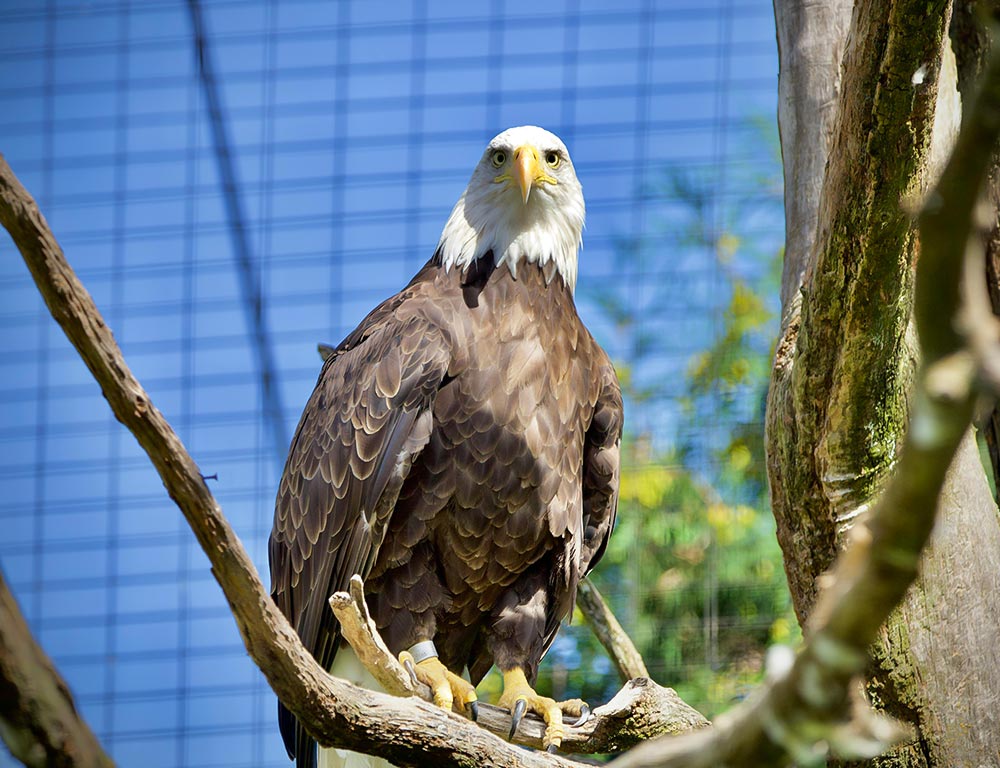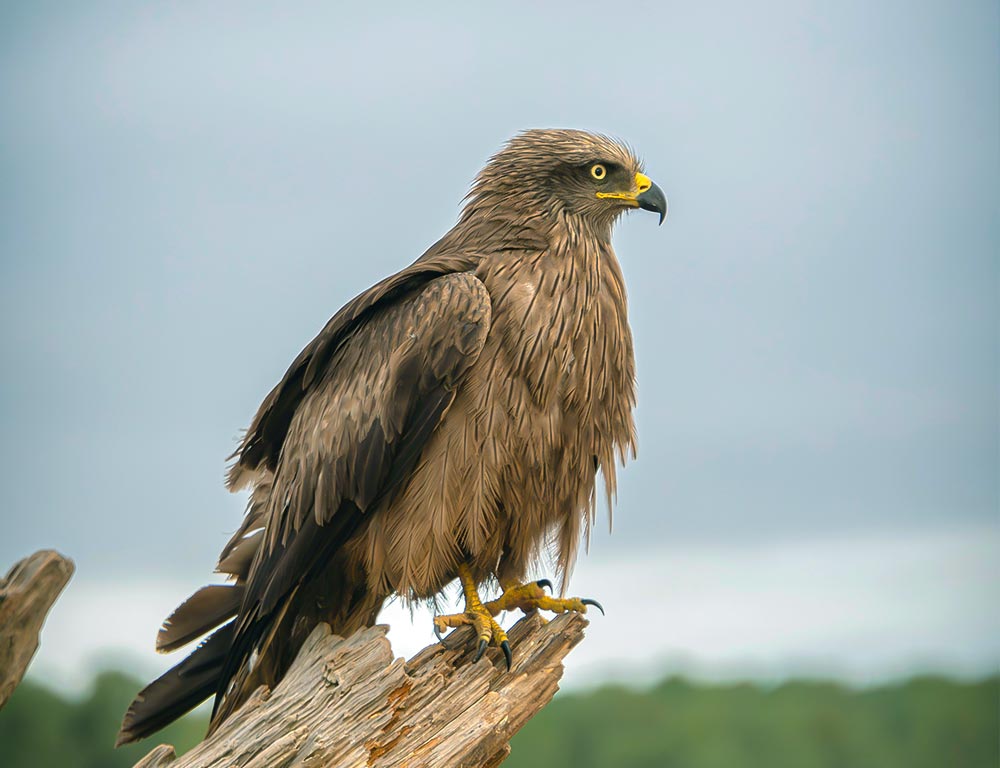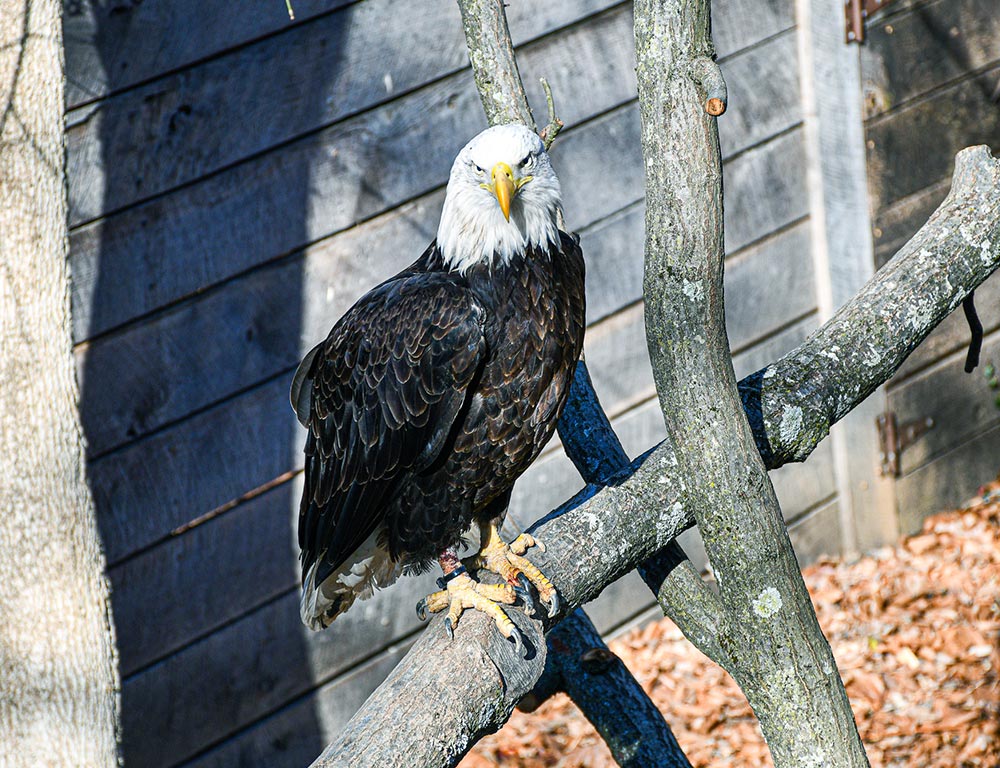Eagles in Indiana soar across the skies and through the state’s cultural and ecological fabric.
As majestic symbols of freedom and strength, eagles, particularly the Bald Eagle, hold a revered place in the hearts of Hoosiers.
This captivating bird’s resurgence from the brink of endangerment mirrors a conservation success story, reflecting the tireless efforts to protect habitats and ensure biodiversity.
Indiana’s skies are also graced by the presence of the Golden Eagle, adding another layer to the state’s rich avian diversity. Beyond their ecological roles, these eagles play a pivotal role in tourism, education, and community engagement.
In this exploration of ‘Eagles in Indiana,’ we delve into these magnificent birds’ significance, their cultural importance, conservation impact, and the enchantment they bring to the Hoosier state.
Unique Characteristics of Eagles in Indiana

Indiana is home to the bald eagle (Haliaeetus leucocephalus), the only eagle species in the state. Here are some unique characteristics of bald eagles in Indiana:
Symbol of Freedom and Majesty
The bald eagle is not only the national bird of the United States but also a symbol of freedom and majesty. Seeing a bald eagle in the wild can be a powerful and awe-inspiring experience.
Habitat and Nesting
Bald eagles in Indiana typically inhabit areas near large bodies of water, such as lakes and rivers. They build large nests in tall trees near the water and may reuse the same nest for several years.
Migration
While some bald eagles in Indiana are year-round residents, others may migrate from northern regions during winter.
The state provides suitable wintering grounds for eagles, especially around unfrozen open water sources.
Feeding Habits
Bald eagles are primarily fish eaters, and their diet consists mainly of fish, which they catch by swooping down and grabbing with their talons. However, they are opportunistic feeders and may also consume birds, small mammals, or carrion.
Distinctive Appearance
Adult bald eagles are easily recognized by their distinctive white head and tail, contrasting with a dark brown body. Young eagles have a predominantly dark plumage until they reach maturity at around 4-5 years of age.
Conservation Success
The bald eagle population in Indiana has experienced significant recovery over the years. Conservation efforts, including banning the pesticide DDT and habitat protection, have increased their numbers.
Breeding Success
Bald eagles in Indiana have shown successful breeding behavior, with nests producing eaglets. Young eagles’ successful nesting and fledging are positive indicators of the population’s health.
Observation Opportunities
Indiana provides opportunities for birdwatchers and wildlife enthusiasts to observe bald eagles in their natural habitat, especially in areas near large lakes and rivers.
Some locations may have designated eagle-watching events during winter when these birds are more visible.
It’s important to note that while bald eagles are a success story in terms of conservation, they are still protected by federal and state laws, and it’s crucial to respect their habitat and observe them from a distance to avoid disturbance.
Types of Eagles in Indiana
Indiana has two majestic eagle species—the Bald Eagle (Haliaeetus leucocephalus) and the Golden Eagle (Aquila chrysaetos).
Both play vital roles in the state’s ecological balance and hold cultural significance. Here’s a detailed look at each species:
Bald Eagle

- Scientific Name: Haliaeetus leucocephalus
- Population: The bald eagle population in Indiana has been steadily increasing, and they are no longer considered endangered. Exact population numbers may vary, but conservation efforts have contributed to their recovery.
- Life Span: In the wild, bald eagles typically live up to 20-30 years.
- Size: Bald eagles have a length of 28-40 inches.
- Weight: Adult bald eagles can weigh between 6.5 to 14 pounds.
- Food: Primarily fish, but they are opportunistic and may also eat birds, small mammals, or carrion.
- Wingspan: The wingspan of a bald eagle ranges from 6 to 7 feet.
- Status: The bald eagle was removed from the endangered species list in 2007, but it remains protected by federal and state laws.
The bald eagle, a majestic symbol of freedom, has made a remarkable recovery in Indiana. These birds of prey primarily inhabit areas near lakes and rivers, where they build large nests in tall trees.
Known for their distinctive white head and tail, adult bald eagles showcase impressive aerial displays, soaring with a wingspan reaching up to 7 feet.
They are adept hunters, primarily feeding on fish, which they catch by diving and using their powerful talons.
Bald eagles are also opportunistic feeders, consuming birds, small mammals, and carrion. Their successful nesting and breeding behavior and conservation efforts have contributed to their population rebound.
While no longer endangered, these iconic birds are protected, and efforts to preserve their habitat remain crucial.
Golden Eagle

- Scientific Name: Aquila chrysaetos
- Population: The golden eagle is less common in Indiana than the bald eagle, with occasional sightings. Their population in the state may vary.
- Life Span: In the wild, golden eagles can live up to 15-20 years.
- Size: Golden eagles have a length of 26-40 inches.
- Weight: Adult golden eagles typically weigh between 7 to 14 pounds.
- Food: Mainly mammals, birds, and carrion.
- Wingspan: The wingspan of a golden eagle ranges from 6 to 7 feet.
- Status: Golden eagles are not listed as endangered, but they are protected under the Bald and Golden Eagle Protection Act.
The golden eagle, a raptor with impressive strength and agility, is a less common but fascinating sight in Indiana. These birds of prey prefer open landscapes, including mountainous regions and cliffs.
With a wingspan of 6 to 7 feet, golden eagles are powerful fliers, utilizing their keen eyesight to spot prey such as mammals and birds.
They are also known for their opportunistic feeding habits, scavenging on carrion. While not as frequently observed as bald eagles in Indiana, golden eagles play a vital role in the ecosystem.
Conservation efforts aim to protect their habitats and ensure their continued presence in the state. Despite not being listed as endangered, the golden eagle is safeguarded under federal laws to promote their conservation.
Significance of Eagles in Indiana

Eagles in Indiana hold significant cultural, ecological, and symbolic importance, contributing to the state’s identity and natural heritage. Here are key aspects highlighting the significance of eagles in Indiana:
Cultural Symbolism
The Bald Eagle, the national bird of the United States, symbolizes freedom, strength, and patriotism. This symbolism resonates in Indiana, fostering a connection with the broader American identity.
Conservation Success Story
The recovery of the Bald Eagle population in Indiana symbolizes successful conservation efforts. Once endangered, the species’ resurgence reflects the positive impact of habitat preservation, anti-pollution measures, and wildlife management.
Tourism and Recreation
The presence of eagles attracts nature enthusiasts and tourists to Indiana, particularly during eagle-watching events. This contributes to local economies as people travel to witness these majestic birds in their natural habitat.
Educational Opportunities
Eagles serve as excellent educational tools for teaching about ecosystems, food webs, and conservation. Schools and nature centers often use them to engage students in environmental science and wildlife preservation.
Wildlife Management Indicator
As apex predators, eagles are indicators of ecosystem health. Monitoring their populations helps assess the overall condition of Indiana’s water bodies and habitats, providing valuable insights for wildlife management and conservation planning.
Native American Symbolism
Eagles hold spiritual significance in Native American cultures, symbolizing power, vision, and a connection to the divine. Their presence in Indiana may resonate with indigenous communities, adding cultural depth to the landscape.
Environmental Stewardship
The presence of eagles raises awareness about the importance of preserving natural habitats, water quality, and biodiversity. It encourages individuals and communities to adopt practices that support environmental stewardship.
Photographic and Artistic Inspiration
Eagles inspire photographers, artists, and writers, contributing to Indiana’s artistic and cultural landscape. Their majestic appearance and behaviors offer captivating subjects for creative expression.
Economic Impact
Eagle-related tourism, including guided tours and events, contributes to the economy through increased local businesses, such as hotels, restaurants, and outdoor recreation services.
Community Engagement
Eagle-watching events and conservation initiatives provide opportunities for community members to come together, fostering a sense of pride and shared responsibility for the well-being of local wildlife.
Eagles in Indiana transcend their role in the ecosystem. They are symbols of national and local pride, tourism and education contributors, environmental health indicators, and inspiration sources for artistic and cultural endeavors.
Their presence enriches the lives of residents and underscores the importance of balancing human activities with preserving the natural world.
Wrapping Up
The presence of eagles in Indiana is a testament to ecological resilience and a celebration of cultural identity and successful conservation efforts.
From the soaring majesty of the Bald Eagle, symbolizing freedom and strength, to the lesser-known yet captivating Golden Eagle, these birds enrich Indiana’s landscapes.
Their resurgence from endangered status reflects their dedication to environmental stewardship. Beyond being wildlife icons, eagles inspire tourism, education, and artistic expression.
As Hoosiers witness these magnificent birds in their natural habitat, they become integral partners in ongoing efforts to safeguard habitats, ensuring the continued thriving of these aerial wonders.
The significance of eagles in Indiana extends beyond ecological roles; it encapsulates a shared commitment to preserving the state’s natural heritage for future generations.